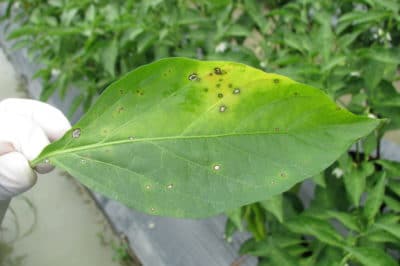Fungal Diseases
Some common fungal diseases known to afflict pepper plants are:
- Powdery Mildew
- Southern Blight
- Damping Off
Powdery mildew (PM) shows up just as it sounds, as a mildew-like white powder on the surface of the leaves. This disease is common in moist climates and toward the end of the season. Prevent PM by pruning for maximum airflow and avoid overhead watering. Remove any affected foliage and mulch.
Southern blight affects peppers in warm regions. This fungus lives in the soil and causes the stems of young plants to rot, killing the entire plant. Lots of organic compost applied as a top dressing will help reduce the presence of blight. Crop rotation is another method of control.
Damping off occurs when peppers are seedlings. It affects the newly growing stems of seedlings causing them to rot and the plant to fall over. This fungus lives only in very wet habitats. Avoid overwatering seedlings or keeping them in too high of humidity.
Bacterial Diseases
- Bacterial Leaf Spot
- Soft Rot
Bacterial Leaf Spot (BLS) is caused by a bacteria usually on the seed of the plant but once introduced it also survives in the soil. Symptoms include black and brown spotting that occurs on the foliage eventually leading to leaf drop. Prune or pull affected plants. Purchase disease-free seed or disease resistant varieties and practice crop rotation.
Soft Rot is another bacterial infection that shows up only on picked fruits. Once harvested, affected fruits exhibit sunken lesions and bacterial ooze. This disease is associated with warm, humid weather patterns and flying fruit-eating insects. Reduce humidity if possible and control insect populations.
Other Diseases
Parasitic soil-dwelling nematodes can infect peppers much like a disease. This problem is often called ‘pepper disease.’ Symptoms include wilted, stunted plants with stubby roots and weak root systems. Encourage beneficial predatory nematode populations by applying aerated compost tea. There are new resistant pepper varieties.
Viruses can also affect peppers. The Mosaic virus is the most commonly seen. This causes leaf curling, stunted growth, and mottled fruit. Viruses can be transferred just by touching plants so sanitation in the field is crucial. Remove affected plants and do not plant peppers in that location for two years. Application of compost or compost tea will help.
